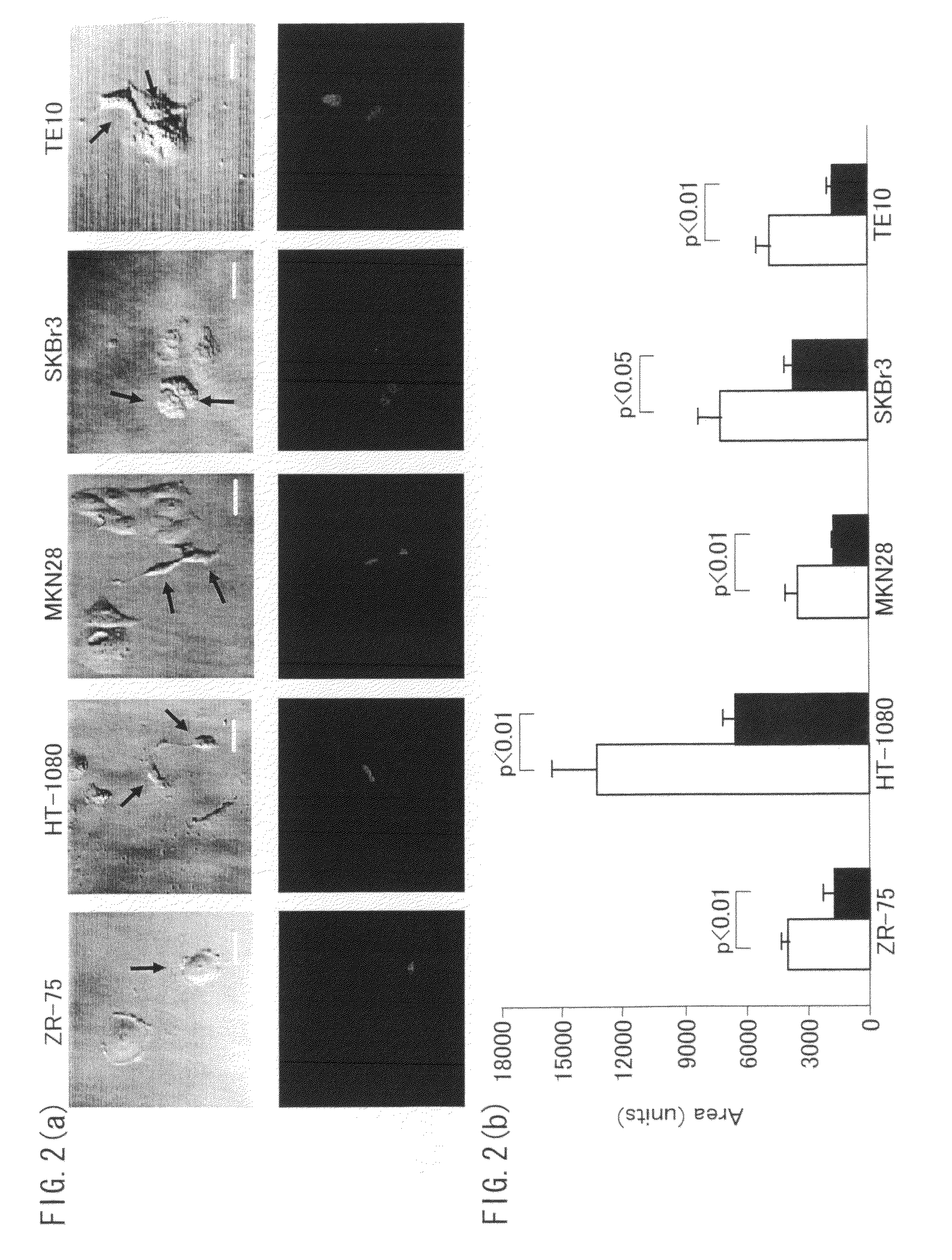siRNA specific to WT1 17AA(−)isoform and use thereof
a technology of wt1 and isoform, applied in the field of wt1 specificity, can solve the problems of insufficient specificity, high efficiency in suppressing the expression of wt1 gene, and using antisense oligo-dna, and achieve the effect of achieving specific anticancer function and inducing apoptosis
- Summary
- Abstract
- Description
- Claims
- Application Information
AI Technical Summary
Benefits of technology
Problems solved by technology
Method used
Image
Examples
example 1
Induction of Morphological Change in Various Types of Cancer Cells by Constitutive Expression of WT1 17AA(−) / KTS(−) Isoform
[0154]In order to examine how a WT1 gene affects actions of a cancer cell, any one of four WT1 genes was stably expressed in TYK ovary cancer cells. Then, TYK cell clones in which the transduced WT1 isoform was highly expressed were isolated (FIG. 1(a)). In the TYK cell, a stable expression of the WT1 17AA(−) / KTS(−) isoform induced a morphological change characterized by a cell morphology having a small size and a fibroblast-like shape (FIGS. 1(b) and 1(c)). In contrast, stable expressions of WT1 isoforms other than the 17AA(−) / KTS(−) isoform did not induce any morphological change in the TYK cell.
[0155]Furthermore, in order to examine whether or not the WT1 17AA(−) / KTS(−) isoform induces a morphological change in various cancer cells other than the TYK cell, a GFP-tagged WT1 17AA(−) / KTS(−) isoform was transiently expressed in MKN28 cells, ZR-75 cells, SKBr3 cel...
example 2
Suppression of Cell-Substratum Adhesion by Constitutive Expression of WT1 17AA(−) / KTS(−) Isoform
[0157]In order to examine whether or not a morphological change observed in a cell transduced with WT1 17AA(−) / KTS(−) isoform was attributed to a change in ability of the cell to spread, effects of a constitutive expression of the WT1 17AA(−) / KTS(−) isoform on cell-substratum adhesion was analyzed in regard to TYK cells. Results of a cell attachment assay indicated that, in cell clones (n=4) transduced with the WT1 17AA(−) / KTS(−) isoform, adhesion of the cells to substrate was significantly weakened compared to cell clones (n=4) transduced with a Mock vector (FIG. 3(a)). Moreover, results of a cell detachment assay indicated that, in cell clones (n=5) transduced with the WT1 17AA(−) / KTS(−) isoform, strength of cell-substratum adhesion was significantly reduced compared to cell clones (n=5) transduced with the Mock vector (FIG. 3(b)). In the cell detachment assay, 53.3% of the cells transd...
example 3
Enhancement in Cell Movement by Constitutive Expression of WT1 17AA(−) / KTS(−) Isoform
[0158]In order to examine how a constitutive expression of WT1 17AA(−) / KTS(−) isoform affects cell migration, cells transduced with the WT1 17AA(−) / KTS(−) isoform were analyzed in terms of individual migration, collective migration, and in vitro invasion.
[0159]Movements of individual TYK cell transduced with the WT1 17AA(−) / KTS(−) isoform were evaluated by using a time-lapse microscope (FIG. 4(a)). Migrations of the individual TYK cell were recorded at intervals of 2 minutes for 5 hours with (n=19) or without (n=19) a transient expression of GFP-WT1 17AA(−) / KTS(−) isoform in the cell. Then, the cell movements were traced so that velocities of the cell movement were calculated. Results of the experiment that was separately carried out 10 times indicated that random movement velocity of the TYK cells expressing the GFP-WT1 17AA(−) / KTS(−) isoform was increased by 1.8 times compared to the cells not exp...
PUM
| Property | Measurement | Unit |
|---|---|---|
| Time- | aaaaa | aaaaa |
| temperature | aaaaa | aaaaa |
| temperature | aaaaa | aaaaa |
Abstract
Description
Claims
Application Information
 Login to view more
Login to view more - R&D Engineer
- R&D Manager
- IP Professional
- Industry Leading Data Capabilities
- Powerful AI technology
- Patent DNA Extraction
Browse by: Latest US Patents, China's latest patents, Technical Efficacy Thesaurus, Application Domain, Technology Topic.
© 2024 PatSnap. All rights reserved.Legal|Privacy policy|Modern Slavery Act Transparency Statement|Sitemap



